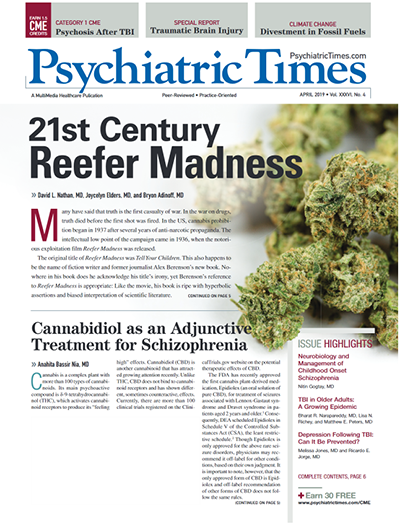Publication
Article
Psychiatric Times
Preventing Suicide When Caring for Patients With a History of TBI
Author(s):
The association between traumatic brain injury and negative psychiatric outcomes has a relatively long history. A review of the current state of the science and strategies for intervention.
©Dirk Ercken

TABLE 1. Acute therapeutic risk management

TABLE 2. Chronic therapeutic risk management

The Current State of the Science and Strategies for Intervention
The association between traumatic brain injury (TBI) and negative psychiatric outcomes, including suicide, has a relatively long history. However, a focus on TBIs sustained by patients who served in recent conflicts in Iraq and Afghanistan, as well as by those who play sports has resulted in a resurgence of interest in acute and post-acute sequelae. According to the Centers for Disease Control and Prevention, a TBI is a “disruption” in normal brain function secondary to “a bump, blow, or jolt to the head.”
The vast majority of TBIs sustained are mild in nature. That is, the disruption of brain functioning at the time of injury is relatively brief (eg, loss of consciousness less than 30 minutes). The severity of injury (mild [concussion], moderate, severe) is determined based on the disruption of brain functioning at the time of injury and is associated with physical and psychological outcomes. Patients with more significant disruptions of brain functioning at the time of injury (eg, loss of consciousness greater than 24 hours) are at increased risk for long-term functional impairment.
Although psychiatrists are intimately familiar with the terms suicidal ideation, suicide attempt, and suicide, clinicians, researchers, and policy makers have long struggled with the lack of universally agreed upon definitions. In light of this, both the Departments of Veterans Affairs and Defense adopted the Self-Directed Violence Classification System (SDVCS).1 Within the system, key terms that are related to the basic clinical phenomena of suicide and suicide-related behaviors are defined. The use of operationalized systems helps to facilitate communication regarding both level of risk and treatment planning.
Epidemiology
Seminal epidemiological work in the area of suicide and TBI was conducted by Teasdale and Engberg,2 who used a Danish population register of hospital admissions to determine rates of suicide among those with concussions, cranial fractures, and cerebral contusions/traumatic intracranial hemorrhages. Their findings suggest increased risk among members of all three groups, when compared with members of the general population (3.0, 2.7, 4.1). Of note, the researchers did not adjust for history of psychiatric condition.
A similar study found that history of TBI was associated with an increased risk for death by suicide; however, the hazard ratios identified suggest a more modest relationship (any TBI 1.55, concussion/fracture 1.98, and cerebral contusion/traumatic intracranial hemorrhage 1.34).3 Findings also highlight the key role that co-occurring psychiatric conditions play in increasing risk for suicide among those with a history of TBI.
Using nationwide registries from Denmark, Madsen and colleagues4 found that persons with TBI were at increased risk for suicide compared with the general population. Having access to pre- and post-injury records of all individuals living in Denmark allowed the researchers to examine several key areas. They found that those with a history of severe TBI had a higher risk for suicide than individuals with a mild TBI. In addition, pre- and post-history of psychiatric illness increased risk for death by suicide after a TBI.
Fralick and colleagues5 conducted a systematic review and meta-analysis to examine the risk of post-concussion suicide. Their findings suggest that compared with persons with no history of TBI, sustaining a concussion was associated with a two-fold increased risk for suicide. The authors also highlighted challenges associated with quantifying the “typical” time between injury and suicide, as well as identifying specific cohorts, among those with a history of TBI, who may be at heightened risk for death by suicide.
Long-term negative outcomes
Acute sequelae are common among patients with a history of all severity levels of TBI. Depending on the severity of injury, mechanisms underlying symptoms are believed to vary and may include inflammation, as well as structural damage to the brain.6 Most individuals who sustain a mild TBI can expect to return to baseline functioning. However, those with moderate to severe TBIs are likely to have long-term impairment, which often impacts psychosocial functioning.
This simplified explanation of injury severity and sequelae begins to highlight clinical challenges associated with understanding increased risk related to injury history. For example, it may be that an injury (exposure) in persons with mild TBI results in heightened inflammation, and when coupled with other exposures known to be associated with inflammation (eg, poverty, acute stress, cardiovascular disease), a threshold is reached that places individuals at increased risk for death by suicide (see Brundin et al7). This is consistent with conclusions asserted by Teasdale and Engberg, who in 2001 wrote “the increased risk of suicide among patients who had a mild traumatic brain injury may result from concomitant risk factors such as psychiatric conditions and psychosocial disadvantage.”2
Conceptualizing risk among patients with more severe injuries also requires clinicians to consider multiple factors including neuroanatomic and cognitive dysfunction, and psychosocial impairment. In developing a neurocognitive model underlying suicidal processes for members of the general population, Jollant and colleagues8 highlighted several key areas of impairment that are frequently observed among those with moderate to severe TBI including impaired decision making and problem-solving abilities.
Moreover, findings indicate that patients with a history of a suicide attempt and moderate to severe TBI are not able to respond to task demands.9 Based on the results, Brenner and colleagues suggest that during a suicidal crisis this response pattern may result in impulsive decisions aimed at relieving current distress (ie, engaging in suicidal behavior), without considering alternatives (ie, alternate coping strategies).
Work by Simpson and Tate10 has focused on increased risk for hopelessness among those with moderate to severe TBI. In addition to being a strong predictor of suicide among those without a history of TBI, hopelessness has been widely observed among patients with histories of TBI, with rates of moderate to severe hopelessness as high as 35%.10,11
Among patients with more severe injuries, such hopelessness is often in part related to a loss of sense of self and purpose post-injury. For example, in qualitative interviews among Veterans with a history of TBI “expressed feelings of sadness, anger, frustration, and helplessness in regards to this loss, particularly when describing their decreased sense of masculinity and increased sense of burdensomeness.”3
Evaluation of suicide risk among patients with TBI requires the clinician to consider injury severity and the potential impact of multiple exposures as well as psychiatric history and past and present psychological stressors. Wortzel and colleagues12 advocate for therapeutic risk management, a patient-centered approach that emphasizes augmenting evaluations with structured instruments, stratifying risk in terms of severity (high, intermediate, low) and temporality (acute, chronic) in addition to developing and documenting a safety plan.
Stratification of risk by severity and temporality facilitates clinical decision making (Tables 1 and 2). Safety planning, a collaborative process to identify coping strategies and sources of support for individuals to use during a crisis, should be considered a best-practice for patients at risk for suicide. Findings from Barnes and colleagues13 suggest that use of safety plans is feasible among those with moderate to severe TBIs. Repetition of content during sessions, as well as inclusion of members of the individual’s support system in the process is encouraged (see Department of Veterans Affairs14).
Intervention strategies
In addition to a source of support during times of crisis, a safety plan can be used as a starting point for treatment. That is, in completing the initial safety plan, patients and clinicians can identify areas for intervention including drivers of suicidal thoughts (warning signs), as well as internal and external sources of support.
Although drivers of suicidal thoughts should be addressed (eg, depression) using evidence-based strategies (medications, psychotherapy) the clinician and patient should also focus on immediate strategies to reduce imminent risk. For example, lethal means safety counseling is a process by which providers engage patients and their family members in a discussion regarding ways (eg, firearms, medications) that can be used to engage in suicidal self-directed violence, as well as strategies to promote safety, particularly during periods of increased risk. This includes psychoeducation regarding tangible strategies to facilitate safety including firearm locking devices and medication disposal kits (see Department of Veterans Affairs15).
Although an in-depth discussion of psychopharmacologic and psychotherapeutic interventions within this article is not feasible, it is important to note that individuals with moderate to severe TBI can benefit from traditional treatments. See Jorge and Arciniegas16 for information regarding prescribing for more severe injuries. In addition, the results for Window to Hope, an intervention for moderate to severe TBI and hopelessness, have been positive. The findings show that patients with cognitive impairments can benefit from psychological interventions aimed at preventing suicide.17
Conclusions
As with most things involving the brain, the relationship between TBI and suicide is complicated. Nonetheless, it is vital that clinicians, particularly, those who are less familiar with working with patients living with TBI, increase their level of comfort in terms of asking about injury history, and incorporating such findings into the conceptualization of suicide risk. Doing so requires neither an overemphasis on TBI history (eg, promoting the connection between chronic traumatic encephalopathy and suicide), nor a lack of appreciation for how a TBI history can influence acute or long-term factors known to increase death by suicide.
Disclosures:
Dr Brenner is Professor, Departments of Physical Medicine and Rehabilitation, Neurology, and Psychiatry and Neurology and Director of Clinical Research, Marcus Institute for Brain Health, University of Colorado, Anschutz Medical Campus; Mr Grassmeyer is Study Coordinator, Marcus Institute for Brain Health, University of Colorado, Anschutz Medical Campus; and Dr Kelly is Director, Marcus Institute for Brain Health, University of Colorado, Anschutz Medical Campus.
The authors report no conflicts of interest concerning the subject matter of this article.
References:
1. Department of Veterans Affairs. Self-Directed Violence Classification System. 2017. https://www.mirecc.va.gov/visn19/education/. Accessed February 27, 2019.
2. Teasdale TW, Engberg AW. Suicide after traumatic brain injury: a population study. J Neurol Neurosurg Psychiatry. 2001;71:436-440.
3. Brenner LA, Homaifar BY, Adler LE, et al. Suicidality and veterans with a history of traumatic brain injury: precipitants events, protective factors, and prevention strategies. Rehab Psychol. 2009;54:390-397.
4. Madsen T, Erlangsen A, Orlovska S, et al. Association between traumatic brain injury and risk of suicide. JAMA. 2018;320:580-588.
5. Fralick M, Sy E, Hassan A, et al. Association of concussion with the risk of suicide: a systematic review and meta-analysis. JAMA Neurol. November 2018; Epub ahead of print.
6. Mayer CL, Huber BR, Peskind E. Traumatic brain injury, neuroinflammation, and post-traumatic headaches. Headache. 2013;53:523-1530.
7. Brundin L, Bryleva EY, Thirtamara Rajamani K. Role of inflammation in suicide: from mechanisms to treatment. Neuropsychopharmacol. 2017;42, 271.
8. Jollant F, Lawrence NL, Olie E, et al. The suicidal mind and brain: a review of neuropsychological and neuroimaging studies. World J Biol Psychiatry. 2011;12:319-339.
9. Brenner LA, Bahraini N, Homaifar BY, et al. Executive functioning and suicidal behavior among veterans with and without a history of traumatic brain injury. Arch Phys Med Rehab. 2015;96:1411-1418.
10. Simpson G, Tate R. Suicidality after traumatic brain injury: demographic, injury and clinical correlates. Psychol Med. 2002;32:687-697.
12. Wortzel HS, Shura RD, Brenner LA. Chronic traumatic encephalopathy and suicide: a systematic review. Biomed Res Int. 2013;2013:424280.
13. Barnes SM, Monteith LL, Gerard GR, et al. Problem-solving therapy for suicide prevention in veterans with moderate-to-severe traumatic brain injury. Rehab Psychol. 2017;62:600-608.
14. VA Suicide Prevention Resources. What Is a Safety Plan? 2018. https://starttheconversation.veteranscrisisline.net/pdf/what-is-a-safety-plan. Accessed February
15. Department of Veterans Affairs. Lethal Means Safety and Suicide Prevention. 2018. https://www.mirecc.va.gov/lethalmeanssafety/. Accessed February 27, 2019.
16. Jorge RE, Arciniegas DB. Neuropsychiatry of traumatic brain injury. Psychiatric Clin. 2014;37:9-15.
17. Brenner LA, Forster JE, Hoffberg AS, et al. Window to Hope: a randomized controlled trial of a psychological intervention for the treatment of hopelessness among veterans with moderate to severe traumatic brain injury. J Head Trauma Rehab. 2018;33:e64-e73.







